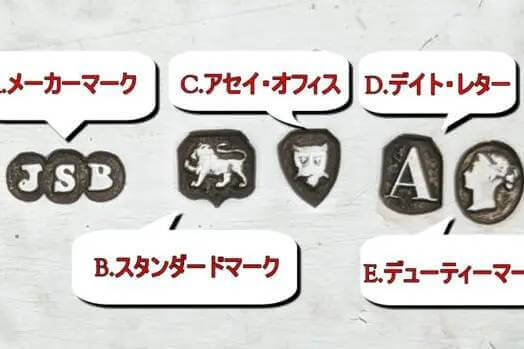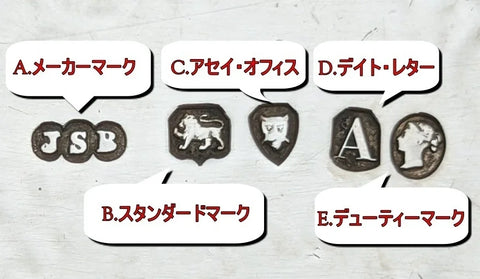A hallmark of British silverware
Posted by WATANABETAIGA

What is Hallmark?
All British silver products have a small mark called a hallmark.
When it comes to pocket watches, the silver cases of British watches are also engraved.
European silver products have hallmarks, stamped with marks to certify purity, etc., and these are said to date back to the 4th century Eastern Roman Empire.
The British hallmark system was established by law during the reign of Edward I in the 14th century, and silver products were required to be sterling silver (92.5% purity).
This was apparently the standard because 100% pure silver is too soft and difficult to process.
The remaining 7.5% is copper or other materials, and in the world of antique silver, it is common to refer to anything as "pure silver" if it is sterling silver or higher.
The word " hallmark" seems to have originated in 1327 when Edward III authorized the establishment of the Worshipful Company of Goldsmiths, who inspected precious metals (gold, silver, platinum) and stamped them to certify their purity at their headquarters in London (Goldsmiths' Hall ).
In the 16th century, financial pressures led to the circulation of low-quality silver coins, so a more rigorous hallmark system similar to the modern system was established in 1544.
Besides the UK, other countries such as France, Germany and Switzerland have also had hallmark systems for a long time, but British hallmarks are characterized by a high level of trust as they are classified not only by purity but also by the year, place and manufacturer of the item, and are strictly enforced compared to other countries, including penalties for violators.
How to see Hallmark

| A. Manufacturer's mark | The abbreviation of the manufacturer (workshop) is engraved on it. |
| B. Standard Mark | This is a stamp indicating purity. If it is sterling silver (92.5%) it has a mark of a lion facing left, called a lion passant . If it is Britannia Silver* (95.84%) then it has the Goddess mark. *This was the standard from around 1697 to 1720. |
| C. Asay Office | There are assay offices (Assay offices) in major cities in the UK and you can find out which Assay office it was assayed at. The main ones are London (lion's face), Birmingham (ship's anchor) and Sheffield (crown). |
| D. Date Letter | Indicates the year it was appraised. The alphabet is used in different capital letters, font styles and borders, and may vary depending on the assay office even for the same year. Before 1974, the renewal months seemed to vary depending on each office. (London in May, Birmingham and Sheffield in June) |
| E. Duty Mark | This is a mark that certifies payment of tax. Silverware made between 1784 and 1890 was taxed and stamped with the profile of the King at the time. However, they may not correspond exactly to the king's reign years. |
The size of the hallmark and the order of the markings vary depending on the size of the silver item and where it is engraved.
Also, if the teapot has separate parts, such as the body and lid, each part will have a hallmark engraved on it, and if the teapot has been repaired or replaced at some point, different parts may have different hallmarks engraved on them.
Even small components such as the links of an Albert Chain are stamped, but because the area for stamping is too small, sometimes only the standard mark is stamped, or sometimes only the largest component has the maker's mark stamped.
Silver plated items also have hallmarks, but they are more complicated to decipher as the rules are not as strict as those for pure silver hallmarks.
How to check the hallmark

There are several books available that explain the hallmark listings.
In particular , "English Silver Hall-Marks" by Judith Banister is said to be the bible for British antique dealers.
You can also check this website .
[Investigation procedure]
- First, determine the assay office. Date letters by year vary depending on the assay office.
- Next, we will distinguish the alphabet in the day letter by capital letters, lowercase letters, font, borders, etc.
If you can identify 1 and 2 above, you can determine the year of manufacture. If it is difficult to identify the assay office or date letter due to wear, etc., proceed as follows.
- Check for duty marks. If they are present, they were made between 1784 and 1890. For men (George III, IV, William IV), they were made between 1784 and 1837. For women (Queen Victoria), they were made between 1838 and 1890.
- Check the manufacturer's mark. You can find out the years when the manufacturer was active by the manufacturer.
- We check the shape of the lion passant. If you find a silver product, no matter how small the part, it will have a lion passant. The shape of the tail and front legs varies slightly depending on the era, so we can determine the approximate era from that.
Silver is a soft metal, so the hallmark may have faded due to wear from years of polishing.
However, even if the markings have faded, it can still be fun to determine the age, place of origin, manufacturer, etc. from the slight characteristics of the markings.
Once you get the hang of it, it will become easy to tell the difference, so be sure to take a look at the silver products you own.











